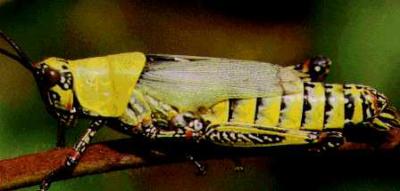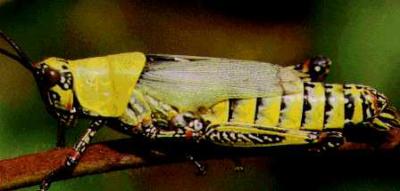Featured Photo

Other Photos

feaured_photo_co
PRIFAS. Courtesy of EcoPort, www.ecoport.org
Is this a Minor Pest?
Yes
Minor Pest Title
Grasshoppers
Minor Pest Description
Several species of grasshoppers attack millets. Short-horned grasshoppers include Zonocerus spp, Oedaleus senegalensis, Kraussaria angulifera, Hieroglyphus daganensis, Diabolocantatops axillaris among others. The long horned edible grasshopper (Homorocoryphus niditulus) is a pest in East Africa.
Grasshoppers defoliate and eat the panicles. They are not of economic importance when present in low numbers. However, invasion by a swarm of grasshoppers may result in serious grain losses.
Minor Pest What to do.
- Conserve natural enemies. Important natural enemies include ants, larvae of blister beetles, parasitic flies, assassin bugs, predatory wasps, birds, lizards, snakes, frogs, and fungi. Robber flies are also major predator of grasshoppers.
- Domesticated poultry (e.g. chickens, turkeys, guinea fowl, geese, and ducks) and wild birds are good for keeping grasshopper populations in check. However, enclose the birds in wire fencing along the perimeter to avoid damage to the crop.
- Ensure the ground is covered with crops, grass or mulch. This is reported to reduce grasshopper numbers since they prefer laying eggs on bare soil.
- Dig or cultivate the land before planting to expose the eggs to predators and to the weather.
- Whenever necessary spray biopesticides. Neem extracts act as antifeedant (grasshoppers stop feeding when exposed to neem products) and affect development of grasshoppers. For more information on neem click here
- IITA (the International Institute of Tropical Agriculture) researchers and partners have developed an environmental friendly biopesticide "Green Muscle" for control of grasshoppers and locusts (www.iita.org).
Minor Pest Position
5
Minor Pest Firstcontent
132
Pest Type
insect
Host Plants
Millet (Revised)
Featured Image
PH Pests Media Gallery
